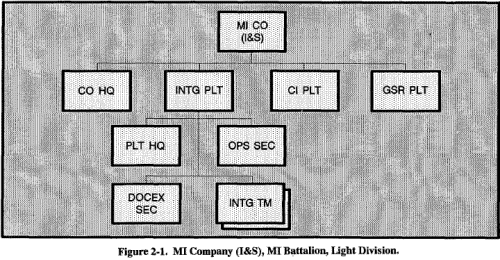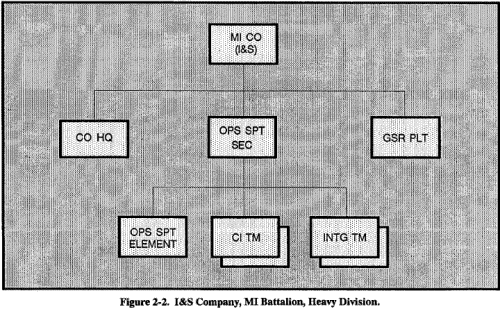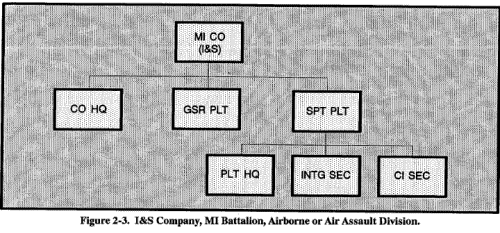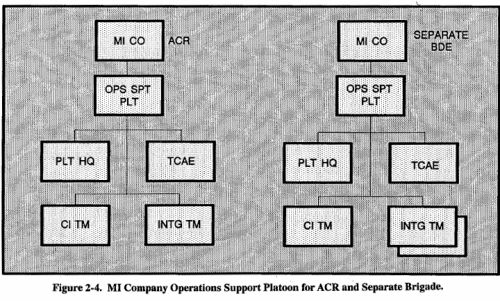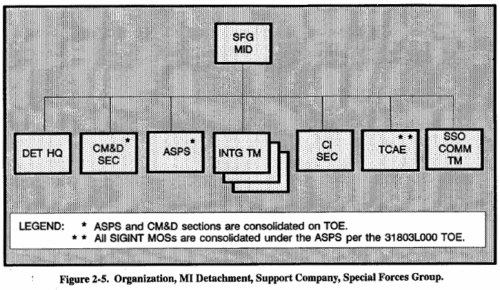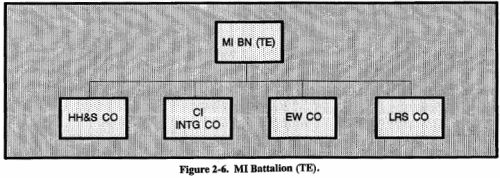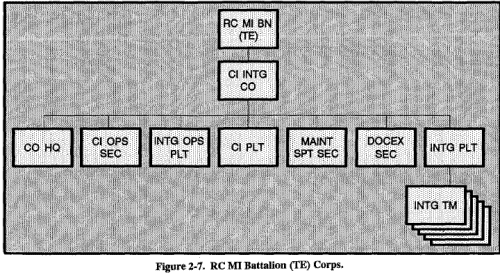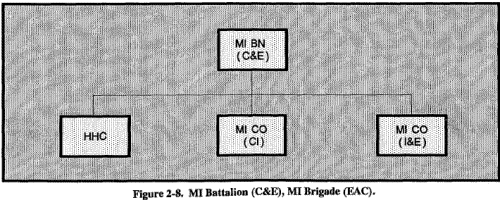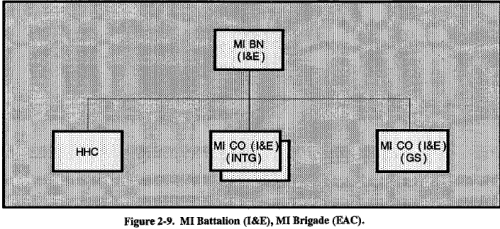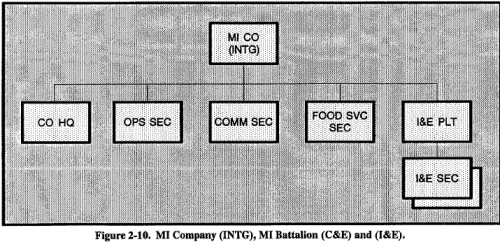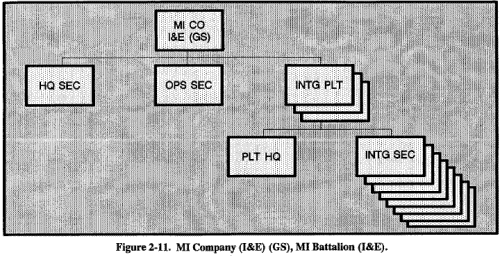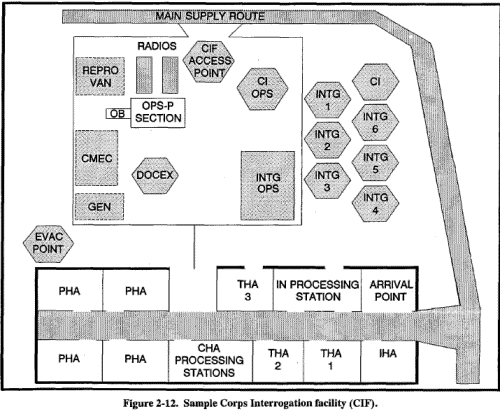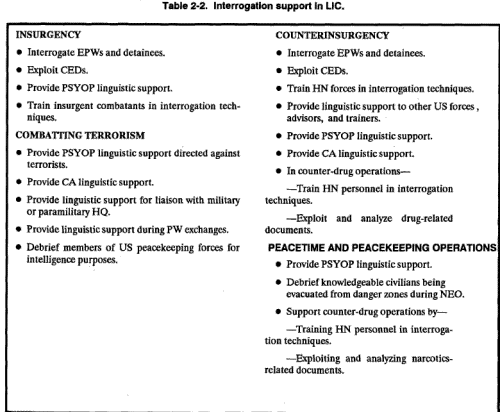|
Site Map FM 34-52 INTELLIGENCE INTERROGATION -- SEPTEMBER 28, 1992 |
|
CHAPTER 2:
COMPOSITION AND STRUCTURE The interrogation architecture (interrogators and interrogation units) is a seamless system that supports operations from brigade to theater level. The dynamic warfighting doctrine requires interrogation units be highly mobile and have automation and communication equipment to report information to the supported commander. Regardless of their employment level, interrogation units should be equipped with state-of-the-art automation equipment, necessary HUMINT software, and dedicated and secure communication equipment with skip echelon, digital, voice, facsimile, and optical scanning capability. This equipment enables interrogators to --
By using secure communication equipment, interrogators are able to disseminate time-sensitive information to the supported commander as answers to his PIR which facilitates decision-making. The Prisoner of War Information System (PWIS) is a databased system maintained by the provost marshal's office at theater level. It has the capability to recall an EPW's evacuation audit trail. This prisoner of war interrogation (IPW) communication and automation system facilitates transmission of EPW-derived information from brigade to theater; it precludes duplicated effort in EPW or CED exploitation. The MI unit commander must ensure interrogators have the necessary equipment to accomplish their wartime mission. The MI unit commander retains overall responsibility for interrogators assigned to his unit. The manner in which these interrogators are controlled depends on how the MI unit is task organized for combat. If interrogators are deployed in general support (GS) of the division, the MI battalion commander exercises control over them through his S3 and the battalion tactical operations center (TOC). If interrogators are deployed in direct support (DS) of a division's subordinate units, they are tasked by the commanders of those units through their S2s. Normally, interrogators are a primary source of OB information. The interrogation element chief should ensure that he or someone appointed to this duty has daily personal contact with the division or corps collection management and dissemination (CM&D) section at the TOC. During these visits, all questions and information pertaining to OB and intelligence target priority lists can be discussed and later disseminated to various interrogators. Interrogator elements must receive all reports and findings made by analysis; in turn, all interrogation reports should reach analysts. Direct contact must be maintained between these two elements, preferably in person or by telephone. This ensures access to important information which may arise between liaison visits. When interrogators are task-organized under the IEW company, the team leader directs the tasking. The DS and GS teams are under operational control (OPCON) to the JEW company when they are supporting that company. The officers responsible for tasking interrogation elements ensure the following steps are accomplished:
INTERROGATOR TASK ORGANIZATIONS Interrogators are not assigned by tables of organization and equipment (TOE) to units below division. However, MI parent units often task interrogators and place them in DS to brigades. For example, In a light division, there are usually enough Interrogators assigned to send forward deployed Interrogation teams, known as "GO" teams, to the brigades to complement light division operations. EPW interrogation may be desirable at all echelons, but is not practicable due to limited numbers of interrogators available. As a minimum, there should be an interrogation element at the division central collection point, corps holding areas, and theater internment facility. Interrogation elements at all echelons are task organized, and may not mirror the TOE organization in their parent unit. Interrogation assets are mobile enough to be shifted in response to new developments. The initial deployment of these assets are guided by the exploitation priority established by the commander. Operations are conducted at an echelon that will allow interrogators the best opportunity to satisfy their assigned collection mission. The areas discussed below should be considered when making the deployment decisions. Number of Interrogators Available The number of interrogators available limit the number of deployment sites that can be used. MI commanders at corps consider how many interrogators will be available for interrogation operations after augmentation has been provided to subordinate divisions. The number of interrogators also play a key role in deciding the level of intense or sustained collection operations they can conduct. Type and Intensity of Combat Operations Intense collection employs all available interrogators with little or no provision for them to rest. The major disadvantage of intense collection is these interrogators become exhausted quickly. Interrogations amount to prolonged conversations under extreme stress. Once the available interrogators are exhausted, collection stops until they recover or additional assets arrive. A severe decrease in interrogation effectiveness can be expected between 12 and 18 hours after the onset of intense collection, with 18 hours as the maximum time possible for intense collection. This kind of all-out effort can be justified when critical information must be obtained or confirmed quickly to forestall a major disaster. Similar problems can be expected during intense CED exploitation. Sustained operations can be maintained indefinitely. They also allow the commander some rested interrogators to use on a contingency basis in a different location. Disadvantages of sustained collection are fewer sources are exploited over a given time and operations are slower. In making deployment decisions, the area where operations are to be conducted must provide the support required by the interrogation element This support includes --
The first interrogation could take place at brigade. Interrogation teams are attached temporarily to brigades in enemy contact when determined appropriate by the division G2. These teams come from the interrogation section of the parent division. Interrogation personnel are organic to separate brigades and armored cavalry regiments (ACRs). Interrogation at brigade level is strictly tactical and deals with information of immediate value. Other information the EPW might possess is developed at higher levels. At brigade, the scope of interrogation changes from hour-to-hour as the tactical situation develops. These interrogations must be geared to cope with any tactical possibility at a moment's notice. Interrogation personnel in DS to brigade will be collocated or immediately adjacent to the division forward EPW collecting point in the brigade support area (BSA). For MI units to receive S2 support, the collecting point and interrogation site will be collocated and accessible to the command post (CP). An MI battalion is organic to each division. It provides combat intelligence, EW, and OPSEC support to light or heavy infantry and airborne or air assault divisions. The MI battalion provides special support the G2 needs to produce combat intelligence. Interrogation personnel organic to the MI battalions compose the interrogation support element. The intelligence and surveillance (I&S) company provides division CI, interrogation, and surveillance support. The I&S company interrogation team manages the division's interrogation assets, including those interrogation teams attached from corps. Additional team duties are --
In a light division, interrogators belong to the I&S Company, MI Battalion. Figure 2-1 shows this structure. Light division MI battalions have 25 interrogators subordinate to the I&S company. Two 5-man DS teams in the interrogation platoon ensure the platoon can provide support to two committed brigades. Platoon headquarters provides C3 for the interrogation element. It consists of a platoon leader and sergeant. The platoon headquarters coordinates with --
Figure 2-1. MI Company (1&S), MI Battalion, Light Division. This consists of a section chief (warrant officer), noncommissioned officer in charge (NCOIC), and two 4-member interrogation teams. The operations section chief manages the interrogation effort to ensure interrogations respond to division intelligence requirements. This consists of a section chief (warrant officer) and three document examiners. The DOCEX section may be used as an additional interrogation team when priority of exploitation and EPW capture rate dictate. The division G2 determines whether interrogation or document examination will have priority. When three brigades are committed in an operation, the DOCEX section may be employed as a third brigade level team. DOCEX assets may also function in an interrogation role when the number of EPWs at the division central collecting point requires additional division level interrogators or when the CEO rate is very low. Each interrogation team consists of a team leader (warrant officer), NCO assistant team leader, and three team members. Teams are normally employed as part of the MI company teams which provide IEW support to the brigades. In a heavy division, interrogators are assigned to the I&S Company, MI Battalion. Figure 2-2 shows this structure. Figure 2-2. I&S Company, MI Battalion, Heavy Division ORGANIZATION (AIRBORNE OR AIR ASSAULT DIVISION) In an airborne or air assault division, interrogators are assigned to the I&S Company, MI Battalion. Figure 2-3 shows this structure. ORGANIZATION (ACR AND SEPARATE BRIGADE) In an ACR or separate brigade, interrogators are assigned to the operations support platoon of the MI company. Figure 2-4 shows this organization. Figure 2-3. 1&S Company, MI Battalion, Airborne or Air Assault Division. Figure 2-4. MI Company Operations Support Platoon for ACR and Separate Brigade. In a Special Forces Group (Airborne) (SFGA), interrogators are assigned to the Military Intelligence Detachment (MID). Figure 2-5 shows this structure. Interrogation teams may be combined with the CI section when not conducting interrogation operations. Figure 2-5. Organization, MI Detachment, Support Company, Special Forces Group. CORPS INTERROGATION ASSETS AND ORGANIZATION At corps, interrogators are assigned to the MI Battalion (Tactical Exploitation) (IE). Figure 2-6 shows this structure. The CI interrogation company consists of a company headquarters, IPW and CI operation sections, CI and interrogation platoons, and a maintenance section. Figure 2-6. MI Battalion (TE). The CI platoon has nine teams and the interrogation platoon normally has eight teams. Interrogators can be placed in a DS role to divisions to augment division interrogation assets. The corps also has a Reserve Components (RC) MI Battalion (TE), which has a subordinate CI interrogation company. Figure 2-7 shows this structure. There are also linguist battalions which augment and support Active Component (AC) units in time of hostilities. Figure 2-7. RC MI Battalion (TE) Corps. ECHELONS ABOVE CORPS INTERROGATION ASSETS AND ORGANlZATION The MI Battalion (Collection and Exploitation [C&E]), as shown at Figure 2-8, has a headquarters and headquarters company (HHC), MI Company (C), and MI Company (Interrogation and Exploitation) [I&E]). Figure 2-8. MI Battalion (C&E), MI Brigade (EAC). The MI Battalion (I&E), as shown at Figure 2-9, has an HHC and three MI companies (I&E), of which one is GS. Two MI companies (I&E) (INTG) operate the theater, joint, or combined interrogation facilities, while the MI company (I&E) (GS) is for GS to echelons corps and below (ECB). The MI Company (Interrogation) of the MI Battalion (C&E) and (I&E), as shown at Figure 2-10, has a company headquarters, operations section, communications section, food service section, and an I&E platoon, consisting of two sections. The MI company (I&E) (GS), MI Battalion (I&E), has a headquarters section, an operations section, and three interrogation platoons, each with a platoon headquarters and eight sections. Figure 2-11 shows this structure. Figure 2-9. MI Battalion (I&E), MI Brigade (EAC). Figure 2-10. MI Company (INTG), MI Battalion (C&E) and (I&E). Figure 2-11. Ml Company (I&E) (GS), MI Battalion (I&E). ENEMY PRISONER OF WAR AND INTERROGATION FACILITIES There are significant differences in EPW and interrogation facilities at each echelon; this is due to the numbers of EPWs, the missions of the various echelons, and the size of the interrogation elements. Initially, the capturing unit is responsible for evacuating and guarding EPWs. In brigade-size operations, battalions evacuate prisoners to brigade collecting points as the situation permits. In most cases, EPWs are evacuated rapidly using backhaul transportation from brigade collecting points to departure areas because they require food and guards, both of which are in short supply at brigade. EPW collecting points should be located close to supply routes to speed evacuation. At brigade level, EPWs can be detained in open fields, courtyards, gardens, jungle clearings, or similar sites if they are hidden from enemy observation. If necessary, these areas can be enclosed with barbed wire for more efficient EPW handling. Because EPWs seldom remain at a forward collecting point for more than a few hours, EPWs are not usually kept in a building or other shelter. Interrogation facilities at battalion and brigade are kept to a minimum. Brigade interrogation personnel should be located adjacent to the brigade forward EPW collecting point in the BSA. The collecting point should be out of sight and sound of other BSA activities. It should be close to normal evacuation routes. The distance between the collecting point and CP is important. When possible, the collecting point and interrogation site should be within walking distance or a few minute's driving distance of the CP. Interrogators with battalions or brigades should have vehicles equipped with radios for rapid communication with their respective intelligence officers and other intelligence agencies. The principal EPW tactical interrogation takes place at division. While the procedure is similar to that used at brigade, the interrogation scope is broader. Previous interrogation reports received from brigade are reviewed. This information is expanded by further interrogations for tactical information to include all OB elements. The interrogators at division level will prepare and disseminate summary interrogation reports. As dictated by the tactical situation, the interrogation facility at division may be augmented by corps interrogation personnel. The division's central EPW collecting point is operated by division MP under the supervision of the division provost marshal. The interrogation section should be located immediately adjacent to the division's central EPW collecting point, normally along the main supply route (MSR) within or near the division support command (DISCOM). The distance between the interrogation facility and G2 section (rear) is not as critical as at brigade level. Personal liaison between the interrogation and intelligence sections, although important, may not be required as frequently as at brigade. At division, the G2 directs interrogation section collection efforts in conjunction with the CM&D section and the MI battalion commander, who serves as one of his principal assistants. Compared to brigade facilities, division interrogation facilities are expanded. This is because the division interrogation section handles and interrogates more captured personnel, and interrogations are conducted in greater detail. When practicable, interrogations at division should be conducted in improvised interrogation rooms in buildings adjacent to the division collecting point. If possible, separate rooms should be available to permit several interrogations at once. The corps EPW holding area is established and operated by MP under the supervision of the corps provost marshal. The Corps Interrogation Facility (CIF) will usually be a more permanent type facility than at echelons below corps. It should consist of operations and interrogation areas with separate, enclosed interrogation booths or rooms. If possible, there should be a separate DOCEX area. Figure 2-12 shows a sample CIF. Figure 2-12. Sample Corps Interrogation facility (CIF). The commander, CI Interrogation Company, MI Battalion (TE), MI Brigade (Corps), is the CIF commander. CIFs are the principal establishment for the exploitation of captured personnel and CEDs. Functions of the centers include --
Continuous coordination between the CIF commander and EPW holding area commander is essential. At a sub-level, it is also important for interrogators to maintain a good working relationship with MP at the holding area. MP, who are in constant contact with EPWs or detainees, can provide interrogators valuable information on individual sources. By properly handling prisoners at all times, they also contribute to the success of interrogation operations by helping to reduce resistance by the sources. The CIF should be administratively and operationally self-sufficient and located within or adjacent to the EPW holding area, close enough to facilitate operations. ADEQUATE INTERROGATION FACILITIES At corps level, particular emphasis should be placed on providing facilities adequate for the interrogation of EPWs of higher positions or rank. Because interrogations will normally last longer than at division, a greater degree of comfort should be provided, If possible. In other respects, the type of interrogation facilities and equipment parallels those found at division. OB analysts are a valuable interrogation facility asset. They ensure PIR, IR, and SIR are updated, and reporting is in response to them. In addition, they maintain a situation map (SITMAP) and OB updates to keep interrogators current on tactical situations. The senior interrogator may assign interrogators to edit INTREPs. They also may use the organizational chain of command to ensure quality control of reporting. When OB analysts are available, the commander may task them to edit reports. DOCEX SECTION The DOCEX section receives documents taken from captured personnel, battlefield casualties, and positions abandoned by the enemy. It processes captured documents; for example, screens for intelligence value, categorizes, and translates. It forwards translation reports on information of immediate tactical value. (Chapter 4 describes document categories.) The scope of interrogations at corps is widened by the commander's intelligence requirements, SIR of the numerous technical service staff agencies, and other intelligence agencies and services. All such special needs for information are coordinated by the corps G2 section. Interrogation must be aware of these overall intelligence requirements to adequately exploit captured personnel. Because of the range of specialized information required, interrogation at corps level should be conducted by interrogators who specialize in fields such as armor, engineering, medicine, and other specialized subject areas. To extract detailed EPW information, the senior interrogator will assign some interrogators as screeners and others to specialized areas. However, he must coordinate, for example, with technical intelligence (TECHINT) assets. This is to prevent duplication or gaps in information obtained. Continuous coordination is required between all echelon interrogation, to ensure a smoothly functioning operation. The corps MI brigade applies the technical expertise, intelligence manpower, and equipment needed by G2 to produce integrated combat intelligence. The corps commander has OPCON, while the G2 has staff supervision over the MI brigade. ECHELONS ABOVE CORPS FACILITIES At echelons above corps (EAC), the MI company (I&E), MI battalion (C&E) or (I&E), MI brigade (EAC), will form the Theater Interrogation Facility (TIF). The TIF, which is commanded by an MI captain, provides interrogation support to the theater or joint command and to national level intelligence agencies. The TIF will --
MEDICAL COMPANY INTERROGATIONS Sometimes it may be advantageous to conduct interrogations at the medical company. Wounded prisoners being evacuated through medical channels are frequently valuable sources of information; however, interrogators cannot represent themselves as medical or Red Cross personnel. The fact the EPW is wounded, and in an "enemy" hospital, puts him in a state of mind conducive to interrogation. The permission of competent medical authority is required before wounded prisoners can be interrogated. US Army doctors and medics are considered competent medical authorities. In their absence, the interrogation may not commence, even upon direction of nonmedical military authority. When interrogating a sick or wounded EPW, great care must be taken to avoid implying that treatment will be withheld if cooperation is denied. The interrogation process must not interfere with timely medical treatment, to include administering medication to relieve pain. INTERROGATION AT BRIGADE AND BELOW Interrogators are not usually attached below brigade level unless the combat situation requires limited tactical interrogation at battalion or lower. In this event, skilled interrogators from the MI battalion will be attached temporarily to committed battalions. They will assist in exploiting EPW immediately upon capture to extract information needed in support of the capturing unit. Interrogations at battalion or lower are brief and concerned only with information bearing directly on the combat mission of the capturing unit. The following are examples of circumstances warranting an interrogation:
Interrogators employed for temporary periods at battalion level receive PIR, IR, and SIR from the supported battalion S2. This will ensure interrogators are fully oriented to the battalion's collection mission. In other instances, interrogators may be placed at brigade in an "on-call" status, from which they can proceed to any of the subordinate battalions as circumstances warrant. Upon completion of a low-level, immediate-type interrogation, they can return to brigade and again become available for immediate employment. Commanders and S2s below brigade level who are unable to obtain interrogator support from higher echelons should include provisions in unit and staff standing operating procedures (SOPs) for the "tactical questioning" (not interrogation) of EPWs or detainees. They should identify assigned personnel for language capability. Interrogation personnel should provide training in the area of tactical questioning to designated S2 personnel. The potential for abuse of the EPW is greatest at the initial capture and tactical questioning phase. With the excitement and stress of the battlefield, it may become easy for unskilled personnel to resort to illegal techniques to elicit critical information. Your instruction must stress the importance of the proper treatment of EPWs. Emphasize that the abuse of an EPW at the initial stage of contact often renders future interrogation futile. If you are engaged in, or supervising the tactical questioning of EPWs, you are responsible for ensuring that EPWs are treated in accordance with the requirements of international and US law. Any tactical questioning conducted must be in response to the supported commander's PIR. Appendix C discusses S2 tactical questioning. At this level the brigade S2 must maintain secure communication with interrogation personnel to ensure requirements are answered. Except under extreme weather conditions, and MP availability, it is not necessary to keep EPWs within the confines of a building or other shelter at battalion level since they will not remain for more than a few hours before being evacuated. The capturing unit escorts or transports EPWs or detainees to the nearest collecting point, and turns them over to the MP. Interrogators in DS of the brigade will screen and categorize all EPWs or detainees, question them, and report information obtained in response to brigade PIR, IR, and SIR. They will do this under time constraints, as all EPWs or detainees must be evacuated without delay. In spite of the temporary nature of the forward EPW collecting point, interrogators should maintain enough space between the collecting point and the interrogation site to ensure the privacy of interrogations. EPWs or detainees should not be able to observe or hear interrogations in progress. INTERROGATIONS IN OTHER OPERATIONS The functions and basic operational techniques employed by the interrogation element attached to the infantry division apply to interrogation elements supporting armored, amphibious, and airborne operations in any terrain or climate. Differences arise primarily in the planning stages and interrogation objectives. These differences normally result from the inherent characteristics of each type of unit and terrain and climate involved. For example, the interrogator engaging in airborne and amphibious operations will be dependent upon intelligence support from higher agencies during the planning stage. This is necessary because the unit does not have actual contact with the enemy until a specific operation begins. Once H-hour arrives, the interrogator will be faced with a rapidly developing and changing tactical situation. At this time, the degree of success correlates to the preparations made during the planning stage. Consequently, the interrogator must make a concerted effort to learn everything possible about the objective area -- terrain, enemy, and weather -- and relate these factors to the mission of the unit supported. Only by taking these steps will the interrogator be able to ensure success, and be prepared to begin interrogations as soon as possible after contact with the enemy is established. Interrogation objectives depend upon the mission assigned and type of unit supported. Special Forces perform five primary missions:
The primary role of Special Forces is to influence deep, close, or rear operations beyond the forward limits of conventional military forces. These operations may extend into a hostile nation's homeland or into the territory of hostile states that threaten lines of communication in the friendly strategic rear. The Special Forces Group (SFG) normally deploys three two-person teams, as required, to support group operations. One of the teams may be attached to the joint interrogation facility (JIF). Special Forces interrogation activities include, but are not limited to --
The assault landing team is the basic subordinate task organization of the assault echelon of a landing force. Regardless of whether a battalion or brigade landing team is the basic element, it will operate independently during the first stages of the landing, and be organized to land, overrun beach defenses, and secure terrain objectives. The interrogation element, along with CI teams, should participate in all aspects of the planning phase affecting the landing force to which it is attached. Interrogators should conduct specialized training. The chief interrogator should coordinate with the landing force intelligence officer on all matters concerning interrogators after the landing has been made. The interrogators obtain as much background information about the enemy as possible to interrogate captured enemy personnel. Interrogators should study --
Interrogators should engage in other phases of training, including rehearsals, to smoothly execute embarkation, movement, and debarkation operations. The interrogation element attached to an amphibious landing force will be OPCON to the landing force intelligence officer, and employed at his direction. Small interrogation teams may be formed, which will embark on separate ships. Communication silence will place an effective barrier between these teams until that silence is lifted. When the assault begins, organizational artillery, air support, and naval gunfire depend primarily on shore units for accurate target information. As a result, interrogators may be required to concentrate their efforts on target acquisition. The importance of information obtained from captured enemy personnel is magnified when establishing a beachhead. This is because the commander is unable to undertake probing actions to "feel out" the enemy as he can during a more conventional land operation. Interrogators should conduct initial interrogations near the landing beach close to the CP to communicate information without delay. If necessary, interrogators may be sent forward to operate with assault companies. EPW are turned over to the landing force shore party for custody and eventual evacuation. Further instructions on interrogations and EPW handling are in the intelligence annex of the landing force operations order (OPORD). The interrogation of civilians for information of intelligence value also is an important part of the interrogation mission. When headquarters of the next higher echelon above the landing force has landed and established its CP, some of the interrogators may be returned to the command level from which they were originally detached. At this time, collecting points and interrogation facilities can be established and operated as in ordinary ground operations. The shore party or helicopter support teams operate EPW collecting points in the vicinity of the landing beaches. EPW are evacuated from these points to designated ships by landing craft, helicopter, or amphibious vehicle. Retention in the objective areas is begun as increased facilities, supplies, and personnel permit, consistent with reasonable EPW safety from enemy action. The functions and basic methods of operations by interrogation personnel with airborne operations are similar to that of an infantry division. However, the method of employment of interrogators is somewhat different. Interrogators who are to operate with airborne units must understand the peculiarities in operations, as well as in training. The most significant difference between airborne and normal ground operations is airborne operations are usually carried out behind enemy lines. Before the operation, airborne qualified interrogators must --
The command echelon to which interrogators will be attached depends on each airborne battalion for the assault phase. Interrogators move into the objective area with the unit they are supporting. They are OPCON to the unit intelligence officer. As soon as the objective areas and the missions of the respective units within an airborne force are designated, the interrogators who are to take part in the operation must receive details on most aspects of the operation. Interrogators must be provided with --
Interrogators should spend sufficient time coordinating with other intelligence specialists, particularly analysts, to provide a realistic and complete picture of the enemy situation. They must study enemy units identified in the objective area, as well as significant terrain features, to provide a background for more comprehensive interrogations when the first EPWs are captured. Prior to the actual airborne assault, interrogators must know CP locations of the division and its subordinate units. Interrogators involved in airborne operations must anticipate the numerous problems which will affect the interrogation mission. For example, it is conceivable during the assault phase that no basic transportation will be available to interrogation personnel; thus, flexibility is critical in planning and executing airborne operations. COLLECTING POINTS AND INTERROGATION FACILITIES Collecting points and interrogation facilities are established and operated as in other operations when --
AIR ASSAULT (AIRMOBILE) OPERATIONS Air assault operations are characterized by a high degree of tactical mobility. They are conducted by transporting infantry and field artillery units, with the necessary combat support (CS) and combat service support (CSS), into battle by helicopter. Once deployed on the ground, air assault infantry battalions fight like other infantry battalions. The essence of air assault tactics is a rapid tempo of operations over extended ranges. In division air assault operations, to support more than one brigade, there must be corps augmentation. PM 71-101 describes air assault operations. Security of aircraft enroute to landing zones (LZs) is a major concern. Friendly aircraft and air defense support must ensure air routes are free of enemy aircraft and air defense systems. When remotely monitored battlefield sensor systems (REMBASS) are available, friendly ground assets emplace REMBASS along likely enemy ground approach routes in the LZ to detect and report ground movement. Ground surveillance radar (OSR) is employed to warn of enemy movement on friendly flanks. Air assault operations require extensive HUMINT support in operation planning. CI analysis is critical to ensure OPSEC measures are taken to prevent divulging critical information, such as --
CI must also support staging area actions to prevent espionage, sabotage, and acts of terrorism which could adversely affect the operation. Interrogation is a primary source of information for air assault operations IPE. Interrogation support of initial stages of the operation may be critical to its success. The assault force commander needs immediate and current enemy intelligence. Lack of immediate questioning of EPWs captured in securing the LZs or in follow-up actions may cause failure of the operation. Planners must consider the difficulty in getting EPWs back to a support area during the early stages of an air assault operation. Interrogators should support the air assault elements as soon as possible. This may mean an interrogation team is included in the air assault force to operate at a forward EPW collecting point established in the vicinity of the LZ. Normally, one interrogation team should support each air assault battalion during the assault phase. If the air assault battalion is using more than one LZ, the team may be split to support each LZ. After assault units have established a ground link-up, some or all of the interrogators may be returned to the echelon of command from which they were detached. Interrogators supporting the early stages of an air assault operation must be provided with the SIR, which are critical to the operation's success. Interrogators must plan ahead on how to question EPWs to satisfy immediate collection requirements. ARMORED AND MECHANIZED INFANTRY OPERATIONS Armored units normally operate on extensive fronts, with deep zones of action and dispersed formations. Because of the mobility and wide range of action of armored units, interrogation normally is not as detailed as in other divisions. Interrogators must remain mobile, operate with minimum facilities, and be alert for sudden changes in the tactical situation. With a few exceptions, the planning and preparation necessary for interrogators supporting armored units is the same as for those supporting regular infantry units. Since radio is the normal means of communication, all interrogation team members must be familiar with voice radio procedures and know how to operate radio equipment common to armored units. Interrogator personnel who support armored or mechanized units will come under OPCON of the J2, G2, or S2 of the supported unit. Interrogators at all levels of armored or mechanized units must be able to operate during fluid situations, and remain mobile at all times. Because of this mobility, liaison with the J2, G2, or S2 will not be as frequent as in other units. Interrogators must operate with maximum efficiency on the basis of radio communications, messages, and written reports. As in other type units, interrogation personnel remain OPCON to the G2 until operations begin. At that time, the division MI battalion will attach interrogation personnel to subordinate units. After an operation is completed, interrogation personnel will revert to division control, pending a future mission. Normally, interrogations within armored units will be limited to interrogating EPWs for location and deployment of antitank weapons and defenses, enemy roadblocks, and presence of enemy armor. In fast moving offensive operations, interrogators are best employed with the forward elements of the units. EPWs are questioned briefly at the point of capture (POC), and evacuated to division EPW forward collecting points, or are turned over to division MP for evacuation. Interrogators with battalions and brigades in armored operations should have vehicles equipped with radios so they can communicate with the respective intelligence officers and other intelligence agencies. General exploitation techniques and procedures are modified to fit the environment and objectives of each interrogation. EPWs are a primary source of information during tactical operations. The ability to exploit that source is a critical factor in mission success. EPWs are first-hand and last-minute observers of enemy operations. They represent one of the few forms of direct association with the enemy and usually possess valuable information. Other sources of information are enemy and friendly civilians, refugees, defectors, captured agents, and informers. Because these sources may have lived in or passed through areas occupied or controlled by the enemy, they can provide valuable information. CEDs are another important source of information which interrogation personnel will exploit in tactical operations. Documents will be found in the possession of EPWs or other detainees and on the battlefield. Often, they provide critical and sometimes detailed enemy information. US military involvement in tactical operations during and since World War II has shown that conflict generates large numbers of EPWs, other detainees, and CEDs. The higher the intensity of conflict, the larger the number of EPWs, detainees, and CEDs. In OPERATION DESERT STORM, EPWs were captured, and surrendered, in such great numbers that many with information had little or no contact with interrogators until they were transported to rear area collecting points. By this time, any tactical information they had was of limited use. In LIC operations in Grenada and Panama, the EPW capture rate was lower, but the detainee rate was higher. The following factors contributed to an extreme challenge for interrogation operations:
To be successful, interrogation support to tactical operations must be carefully planned. Available interrogation assets must be balanced against the operations objective, enemy situation estimate, and projected EPW capture rates. The formulas in Table 2-1 are used to estimate the approximate division-level EPW capture rates. These formulas could vary according to type of conflict and mission. Table 2-1. Division-level EPW capture rate. EPW capture rate for counterinsurgency operations may be very low. However, failure of the enemy to wear a uniform or other recognizable insignia results in an identification problem. As a result, large numbers of civilian suspects may also be detained during operations. This requires individual screening at brigade and division levels of detained personnel to determine their status and appropriate disposition. In Viet Nam, the ratio of EPWs approximated one for each six detainees taken into custody. Terrorists are a fact of contemporary life. They are dedicated, intelligent, well financed, resourceful, and astute planners. They are difficult to identify and are not easily captured or interned. The use of terrorist tactics worldwide has increased significantly over the past 25 years, and this trend is not expected to abate in the future. Besides peacetime, acts of terrorism should also be expected in time of armed conflict. US forces must be prepared to engage in counterterrorist activities to assist the civil and military police. Current doctrine states counterterrorist activities may involve use of general purpose forces as well as those specifically organized and trained in counterterrorist techniques. There is no data available on projected terrorist capture rates. INTERROGATION OF PROTECTED PERSONS Civilians and refugees caught in the middle of a conflict are protected by the GWS, GPW, and GC. Most of the provisions discussed below apply whether the civilian or refugee is found in the territory of a party to the conflict, or in occupied territory. Civilians and refugees fall into the broadly defined category of protected persons under the GC. It is important to keep in mind that protected persons, even those who might be detained by you, are not EPWs. They must be treated differently and kept segregated from EPWs. The rights and protections afforded EPWs and protected persons, as well as those control and disciplinary measures that may be used against them, are different. Appendix D provides GWS, GPW, and GC provisions for protecting persons rights. INTERROGATOR SUPPORTED OPERATIONS Combat operations which the tactical interrogator supports are discussed below. No matter what the operation is called, it is still incumbent upon the interrogator to gain critical combat information in support of that operation. The interrogator plays a key role to ensure the combat operation is a success. Successful offensive operations demand imagination, thorough coordination, and skilled execution. These operations are characterized by --
Offenses should move fast, follow successful probes through gaps in the enemy defenses, and shift strength quickly to widen penetrations and reinforce successes to carry the battle deep into the enemy rear operations. They should destroy or control the forces or areas critical to the enemy's overall defensive organization before the enemy can react. In the offense, certain principles are essential to battlefield success:
Interrogation provides a high percentage of information on the enemy and terrain which, along with weather, are the key elements in knowing the battlefield. Movement to contact is a tactical operation to find and engage the enemy. The force is organized to hold the bulk of its combat power in the main body. It moves aggressively toward the enemy, making maximum use of IEW resources to find the enemy before the enemy detects the friendly force. When contact is made, combat information and intelligence determine where and with what force to attack and overcome enemy resistance. Interrogation is an important source of that information. In a movement to contact, the friendly force may encounter an enemy defending or moving to contact. Once contact is made, the action must be resolved quickly if the movement to contact operation is to continue. This is normally done by a hasty attack launched as quickly as possible with whatever assets are on hand. No time is available for detailed IPB and analysis, other than what has been done prior to movement to contact. The analyst quickly updates the intelligence analysis for as quickly as possible with whatever assets are on hand. No time is available for detailed IPB and analysis, other than what has been done prior to movement to contact. The analyst quickly updates the intelligence analysis for the commander and continues the update as the attack progresses. IEW resources look deep to determine second-echelon vulnerabilities. These vulnerabilities form the basis for friendly offensive action, particularly deep interdiction. While continuing to look deep, IEW resources also support close operations directly. They continue to be sensitive to enemy vulnerabilities which would bring maximum friendly success when exploited. Where possible, IEW resources support deception operations. In the movement to contact, interrogators should be deployed forward to interrogate EPWs as well as indigenous personnel, particularly refugees, to determine as much as possible about the enemy and terrain which lies in the path of the advancing force. The meeting engagement may be the result of movement to contact. It occurs when a moving force, incompletely deployed for battle, engages an enemy force about which it has inadequate intelligence. Once contact is made, electronic countermeasures (ECM) are employed against enemy key C3 and electronic guidance systems. All available collection resources deploy to determine the size, composition, disposition, capabilities, and intentions of the enemy force. They immediately report critical information, such as the location of assailable flanks and other enemy vulnerabilities, to the force commander. The commander needs this information quickly to decide whether to bypass, attack, or defend against the enemy. Meeting engagement battles can be avoided if IEW resources are effectively integrated and used. If intelligence is effective, the commander can prepare for battle before encountering the enemy force. In hasty and deliberate attacks, IEW tasks are virtually the same. MI resources determine as much information as possible about the enemy's defensive posture. Key information determined by IEW assets includes --
In a hasty attack, the need for rapid collection of combat information is critical. In such an attack it may be advantageous to deploy interrogation teams down to battalion level to operate in a similar manner as in the movement to contact. In the deliberate attack, intelligence on the enemy is more complete, and interrogation support may not be provided below brigade. However, planning for a deliberate attack should task organize interrogation assets to satisfy the greatest need. For example, a committed brigade that conducts the main attack receives the support of two interrogation teams; a brigade in a supporting attack receives only one team; and a brigade in reserve receives no interrogation support. Commanders planning offensive operations must be prepared to conduct exploitation and pursuit actions. Without prior detailed planning for these contingencies, fleeting opportunities to press a successful attack to completion may be missed. IEW resources, particularly MI assets, play an important part in planning for and executing exploitation and pursuit missions. IPB is critical and helps identify enemy vulnerabilities. Intelligence supports targeting by identifying, locating, and tracking enemy forces which may move to counter exploitation forces. After the initial assault, MI assets determine the integrity of enemy defenses. They locate gaps, holes, and weak spots that may be exploited. They determine if the enemy intends to defend in place, delay, or withdraw to subsequent defensive positions. ECM are maximized to increase enemy force confusion. A reconnaissance in force (RTF) is a limited objective operation by a substantial force to obtain information and to determine enemy dispositions and strengths. The RIF also tests enemy reactions to friendly force action. Enemy reactions may reveal major defensive weaknesses which could be exploited. Even when using RIF to gain information, commanders executing it must be alert to seize an opportunity to exploit tactical success. If the enemy situation must be developed across a broad front, a RIF may probe the enemy at selected points. Recognizing that RIF is primarily an information-gathering operation, commanders must carefully consider the risks involved. Precise plans must be made in advance to extricate the force or to exploit success. In many respects, MI RIF support is like movement to contact. Interrogation support is critical since EPWs will be an important source of the information the RIF seeks. Interrogation support, described in movement to contact, may be the most efficient means of supporting the RIF. River-crossing operations are an integral part of land warfare. The objective of any river-crossing operation is to project combat power across a water obstacle while ensuring the integrity and momentum of the force. Because the modern battlefield is so lethal, and small enemy units can be destructive, crossings must be quick and undetected. Therefore, it is essential that rivers be crossed in stride as a continuation of operations. MI units contribute to the planning and execution phases of river-crossing operations:
Based on the picture of the battlefield drawn by the G2 as a result of WB, the commander decides whether the crossing will be --
MI units normally are not part of the assault force; however, GSR teams may accompany the assault force if surveillance of enemy approaches to the exit bank cannot be conducted from the entry bank. Additionally, interrogators should be included in the assault force if immediate EPW exploitation is deemed critical to developing intelligence on the exit-bank battlefield. Evacuation of EPWs back over the crossing site to a support area collecting point normally will be delayed. This is due to the need to get the maximum amount of force across the river in the shortest time. Two-way traffic in the early stages of the crossing may be precluded. A forward collecting point on the exit-bank side of the river may be established immediately behind the assault force, and interrogations can be conducted to obtain information critical to the immediate situation. To accomplish this, organization of interrogation assets as outlined under movement to contact may be employed. Defensive operations can retain ground, deny the enemy access to an area, and damage or destroy attacking forces. They cannot, however, win the battle by imposing the will of the commander on the enemy. For this reason, the defense is a temporary expedient, undertaken only when it is impossible to conduct offensive operations, or when attacking in another area. All defensive actions are undertaken in anticipation of ultimately resuming the offense. Commanders plan the overall defensive effort on the basis of the METT-T. MI assets are allocated within the elements of the organizational framework to support the overall scheme. The IEW principles for supporting offensive operations apply to the defense, as well as to other operations. Interrogation support to defensive operations, likewise, is basically the same as that provided to offensive operations. Listed below are important factors to consider In defensive operations:
Support of defense operations requires the closest management of interrogation assets. The necessity to support the covering force must be balanced against the increased corps rear operations support. The increased emphasis on rear operations may mean fewer corps interrogation assets available to support division. The G2, in coordination with the MI unit commander, may determine that an echelon between the covering force and corps will not be supported. For example, EPWs may be interrogated by DS interrogators supporting the covering force, and then be evacuated back to division, bypassing brigade. Additionally, the five-member DS team, which provides flexibility, may have to be reduced to two or three interrogators. Table 2-2 shows interrogation support in LIC. Table 2-2. Interrogation support in LIC. INSURGENCY
COMBATTING TERRORISM
COUNTERINSURGENCY
PEACETIME AND PEACEKEEPING OPERATIONS
THEATER INTERROGATION FACILITY The EAC interrogation facility will normally be designated as the TIF. A TIF is staffed by US Army interrogators and analysts, with support from Air Force, Navy, Marine Corps, and other US national agencies as required. In a multinational operation, a combined interrogation facility may be established with allied interrogator augmentation. In addition to conventional theater Army operations, a TIF may be established to support a joint or unified command to meet theater requirements during crisis or contingency deployments. MI battalion companies, MI brigade (EAC) provide US Army interrogation support to the EAC TIF. The mission of the TIF is to --
The MI battalion (I&E) has an HHC for C3, and three interrogation companies, of which one is Active Component (AC) and the other two are RC. The companies consist of two MI companies, I&E (EPW support) and one MI company, I&E (GS-EAC). The two MI companies support EPW compound operations. Their elements are primarily for GS at EAC, but may be deployed for DS at corps and division. The MI company (I&E) (GS-EAC) provides priority interrogation and DOCEX support to corps and divisions, to the TIF, and to temporary EPW compounds as required. A TIF is organized into a headquarters section, operations section, and two interrogation and DOCEX sections. It will normally have an attached TSA section from Operations Group, and a liaison team from the Joint Captured Materiel Exploitation center (JCMEC). The JCMEC liaison team assists in exploiting sources who have knowledge of captured enemy weapons and equipment. The headquarters section provides all command, administrative, logistical, and maintenance support to the TIF. It coordinates with --
OPERATIONS SECTION This section (where ideally the officer in charge [OIC] has the 3Q additional skill identifier) is organized into the operations, OB, and communications elements. The operations section --
This element --
Collection missions are tailored and assigned by the CM&D section subordinate to the G2 at corps and division. The same functions are performed at brigade and battalion by the battlefield information control renter (BICC). These elements must ensure the assigned collection mission is passed by secure means, through established channels, to the interrogation element. If interrogators are deployed in a GS role, the CM&D section will pass its interrogator taskings to the MI battalion TOC. If interrogators are deployed in a DS role, they will receive taskings directly from the BICC. The CM&D section (through the MI battalion TOC) or the BICC must maintain close contact with the interrogation element. This contact allows a two-way flow of communication. The CM&D or BICC element needs the contact to accomplish the preceding three steps. They also use the contact to revise the interrogation element's collection mission as required. The interrogation element requires the contact to ensure it receives current guidance, direction, and assistance in solving collection problems. ALL SOURCE ANALYSIS SYSTEM (ASAS) This system provides assistance to the J2, G2, or G3 and MI unit commanders who collect and analyze intelligence and perform CI and EW functions. The following elements feed into the ASAS. Interrogators should maintain close contact with imagery exploitation elements. Interrogators may be required to identify items on air photographs and should report information of interest to the imagery analysis. Imagery analysts can aid interrogation personnel by furnishing photographs for use in connection with interrogation and by verifying leads originally obtained through interrogation. Normally, Interrogation elements coordinate with the TECHINT sections of the RC battalion (IE). The TECHINT section, and its field teams, furnishes guidance and requirements to the interrogation elements through questionnaires and interrogation guides. These are valuable aids to the interrogator in obtaining specific TECHINT information. Interrogators notify the nearest TECHINT personnel to obtain detailed technical information and guidance. At tactical levels, this is the exception rather than the rule, but it may be necessary when information is of immediate tactical value. Coordination between CI and interrogation elements is always necessary. This coordination is effected continuously, directly or indirectly, and at the discretion of the intelligence officer. CI elements are active in the security screening of refugees and civilians in the combat zone. CI personnel and interrogators must work together to ensure proper interrogation of enemy civilians or personnel speaking the enemy's language. Interrogator personnel can further assist the CI effort by --
The corps MP commander operates the corps EPW holding area and provides escort guard support to divisions for EPW evacuation in routine or medical channels. EPWs are evacuated from the corps holding area to the next higher echelon with the least possible delay. The MP commander also arranges and coordinates transportation requirements to include rations and water, if required, for the movement to include number of vehicles, railroad or passenger cars, or aircraft with the time and place of departure. Expeditious EPW evacuation is provided by the prior dispatch of escort guards to establish a ready reserve at the supported divisions. This reserve evacuation capability is maintained by sending additional escort guards on a continuing or as required basis. These guards may also be attached to EPW and processing reception camps as needed. EPW administrative processing is done by MP PW processing units. Processing includes personnel record preparation, fingerprint and identity cards (if needed), and internment serial number assignment. Normally, interrogation elements coordinate with PSYOP elements to obtain information concerning the motivational factors and cultural value systems of the individuals to be interrogated. PSYOP units, as a part of their normal operations, develop detailed analysis concerning psychological and cultural factors of friendly and hostile elements in the AO. Such information will help interrogation personnel to understand the source's altitude, value system, and perception; it will also help to obtain information more rapidly, and at the same time, PSYOP information on current conditions in enemy country or among enemy forces. A PSYOP PIR would be established to cover this requirement. Successful interrogation operations require support from elements within their echelon of assignment, including all major staff organizations. These elements are collectively responsible for the planning that creates the overall environment for interrogators. The intelligence staffs (J2, G2, or S2) direct contribution to interrogation operations has already been discussed. Its general responsibilities are outlined below, along with those of other staff and support elements. The G1 and S1 are responsible for --
The G1 and S1 ensure the echelon's operations plan (OPLAN) contains complete provisions for source handling and evacuation. This plan must satisfy the interests of all other staff officers and provide for --
The J2, G2, and 52 are responsible for supervising appropriate censorship activities relating to sources. They also --
The G3 and S3 are responsible for operations, plans, organization, and training. Where MP assets are not available, or insufficient, they are responsible for obtaining, organizing, and supervising employment of additional personnel as guards. The G3 and S3 --
The G4 and S4 are responsible for storing and maintaining supplies and equipment needed by subordinate units to conduct source handling operations, as well as delivering them to subordinate units as they are needed. The G4 and S4 also supervise --
CIVIL-MILITARY OPERATIONS (GS AND S5) The G5 and S5 are responsible for CA They --
Besides the major staff elements, an interrogation element requires support from several other elements in order to conduct operations. These elements are discussed below. Secure, reliable communication must be available at or near the interrogation element's deployment site. Priority access to these communications must be arranged to support contact with collection management. This element can provide legal support and advice on the interpretation and application of international regulations and agreements about handling sources. It is also a channel for reporting known or suspected war crimes. This element must clear all sick and wounded sources before they can be interrogated. Seriously sick or wounded sources are evacuated through medical channels. If adequate facilities are not available in EPW hospitals, EPWs are admitted to military or civilian medical facilities where treatment can be obtained. Each EPW is medically examined and weighed at least once a month. Provisions are made for the isolation of communicable cases, disinfection, and inoculations. Retained medical personnel and EPWs with medical training are used to care for their own sick and wounded. All EPWs will be provided NBC protection. If EPWs do not have their own NBC protection equipment, or their equipment is not usable, the detaining forces must provide them with proper NBC gear. The unit ministry team, consisting of the chaplain and chaplain assistant, provides religious support. The team coordinates with the G5 and S5 to provide religious support for refugees, displaced persons, and indigenous civilians. It provides services for EPWs or assists detained clergy of enemy forces and other detained clergy. The team provides burial rites according to the religious rites of combatants. Religious preference of EPWs will be obtained from DA Form 4237-R (Detainee Personnel Record) (see Chapter 3). This element is a channel for reporting known or suspected war crimes. The public affairs officer advises and informs the commander of public affairs impact inherent in planned or implemented EPW operations. The engineer officer assists in planning the construction of EPW enclosures. He also assists the G2 and S2 in developing obstacle intelligence (OBSTINTEL) during the IPB. OBSTINTEL requirements are reflected in the PIR and IR. Much of the IR is technical in nature and warrants direct coordination with the Interrogator to ensure the right questions are asked. Through the J2, G2, and S2, he will also analyze the information collected and its impact On the maneuver and engineer plan. At division and corps, the band may augment the MP by providing security at central collecting points and corps holding areas.
|
